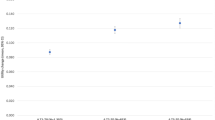Abstract
Background
Spasticity is common in patients with multiple sclerosis (MS) and is a major contributor to disability. Sativex®, an oromucosal spray containing cannabis-based medicinal products, has been found to be effective in reducing spasticity symptoms.
Objective
Our objective was to estimate the cost effectiveness of Sativex® plus oral anti-spasticity medicines compared with the current standard treatment for moderate or severe spasticity in MS in the UK.
Methods
A Markov model was used to assess the costs and benefits of Sativex® plus oral anti-spasticity medicines or current standard treatment based on their effects on the quality of life of patients. The main outcome was the incremental cost-effectiveness ratio (ICER) in terms of costs per additional QALY gained over 5 years of treatment. One-way, multi-way and probabilistic sensitivity analyses were conducted to explore the impact of uncertainties on the findings.
Results
In the base case, Sativex® plus oral anti-spasticity medicines resulted in incremental costs of d7600 and a QALY gain of 0.15 per person over 5 years (ICER = £49 300 per QALY) [year 2009 data for costs]. Findings were sensitive to the costs of Sativex® (price and dose) and differences in utilities between responders and non-responders.
Conclusions
Using a willingness-to-pay threshold of £30 000 per QALY, Sativex® appears unlikely to be considered cost effective by UK funders of healthcare for spasticity in MS. This is unfortunate, since it appears that Sativex® use is likely to benefit some patients in the management of this common consequence of MS.









Similar content being viewed by others
References
Hobart JC, Riazi A, Thompson AJ, et al. Getting the measure of spasticity in multiple sclerosis: the Multiple Sclerosis Spasticity Scale (MSSS-88). Brain 2006; 129: 224–34
Beard S, Hunn A, Wight J. Treatments for spasticity and pain in multiple sclerosis: a systematic review. Health Technol Assess 2003; 7(40): iii, ix–x, 1–111
Crayton H, Heyman RA, Rossman HS. A multimodal approach to managing the symptoms of multiple sclerosis. Neurology 2004; 63 (11 Suppl. 5): S12–8
Medicines and Healthcare products Regulatory Agency. Public assessment report: Sativex oromucosal spray [no. UK/H/2462/001/DC; online]. Available from URL: http://www.mhra.gov.uk/home/groups/par/documents/websiteresources/con084961.pdf [Accessed 2011 Jul 25]
Collin C, Ehler E, Waberzinek G, et al. A double-blind, randomized, placebo-controlled, parallel-group study of Sativex, in subjects with symptoms of spasticity due to multiple sclerosis. Neurol Res 2010; 32(5): 451–9
Ambler Z, Davies P, Gasperini C, et al. A two-phase study of Sativex® in the relief of spasticity due to multiple sclerosis: phase A single-blind response assessment followed by phase B double-blind, randomised, placebo-controlled, parallel-group study [abstract]. Mult Scler 2009; 15: S258
Collin C, Davies P, Mutiboko IK, et al. Randomized controlled trial of cannabis-based medicine in spasticity caused by multiple sclerosis. Eur J Neurol 2007; 14: 290–6
Montalbán X, Wright S. Trial period for new symptomatic treatments: lessons learnt from a Sativex in MS spasticity clinical trial [abstract]. Mult Scler 2009; 15: S272
Novotna A, Mares J, Ratcliffe S, et al. A randomized, double-blind, placebo-controlled, parallel-group, enriched-design study of nabiximols (Sativex®), as add-on therapy, in subjects with refractory spasticity caused by multiple sclerosis. Eur J Neurol 2011; 18: 1122–31
GW Pharma Ltd. Summary of product characteristics: Sativex® oromucosal spray. Leatherhead: electronic Medicines Compendium, 2010
National Institute for Health and Clinical Excellence, National Collaborating Centre for Chronic Conditions. Management of multiple sclerosis in primary and secondary care [clinical guideline no. 8]. London: NICE, 2003
National Institute for Health and Clinical Excellence. Guide to the methods of technology appraisal. London: NICE, 2008
Ragonese P, Aridon P, Salemi G, et al. Mortality in multiple sclerosis: a review. Eur J Neurol 2008; 15: 123–7
Notcutt W, Davies P, Langford R, et al. Results of a randomised withdrawal study of subjects with spasticity due to multiple sclerosis who were receiving long-term Sativex [abstract]. Mult Scler 2009; 15: S258
Wade DT, Makela PM, House H, et al. Long term use of a cannabis-based medicine in the treatment of spasticity and other symptoms in multiple sclerosis. Mult Scler 2006; 12(5): 639–45
UK Department of Health. NHS reference costs 2009. London: Department of Health, 2009
Hyman N, Barnes M, Bhakta B, et al. Botulinum toxin (Dysport®) treatment of hip adductor spasticity in multiple sclerosis: a prospective, randomised, double blind, placebo controlled, dose ranging study. J Neurol Neurosur Ps 2000; 68(6): 707–12
Creedon SD, Dijkers MPJ, Hinderer SR. Intrathecal baclofen for severe spasticity: a meta-analysis. Int J Rehabil Health 1997; 3(3): 171–85
Flückiger B, Knecht H, Grossmann S, et al. Device-related complications of long-term intrathecal drug therapy via implanted pumps. Spinal Cord 2008; 46(9): 639–43
Naumann M, Jankovic J. Safety of botulinum toxin type A: a systematic review and meta-analysis. Curr Med Res Opin 2004; 20(7): 981–90
Acknowledgements
This work was partially funded by the National Institute for Health Research (NIHR) through the Peninsula Collaboration for Leadership in Applied Health Research and Care (PenCLAHRC), which is based at the University of Exeter.
This article presents independent research and the views expressed in this publication are those of the authors and not necessarily those of the NHS, the NIHR or the Department of Health.
The authors declare that they have no conflicts of interest.
LL designed and implemented the model with advice from KS, HP, CR, JS and IL. LL drafted the first and final versions of the manuscript and led the submission and revision process. All authors contributed to the drafting and approval of the final manuscript. KS acts as the guarantor for the overall content.
Author information
Authors and Affiliations
Corresponding author
Additional information
An erratum to this article is available at http://dx.doi.org/10.1007/s40273-015-0262-2.
Rights and permissions
About this article
Cite this article
Lu, L., Pearce, H., Roome, C. et al. Cost Effectiveness of Oromucosal Cannabis-Based Medicine (Sativex®) for Spasticity in Multiple Sclerosis. PharmacoEconomics 30, 1157–1171 (2012). https://doi.org/10.2165/11598470-000000000-00000
Published:
Issue Date:
DOI: https://doi.org/10.2165/11598470-000000000-00000




